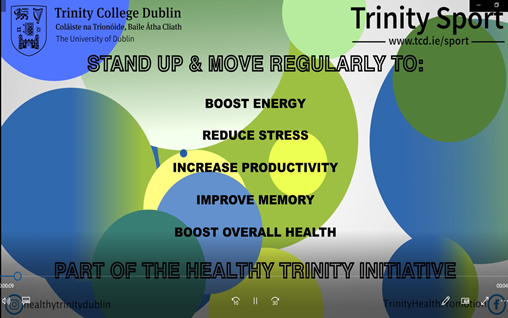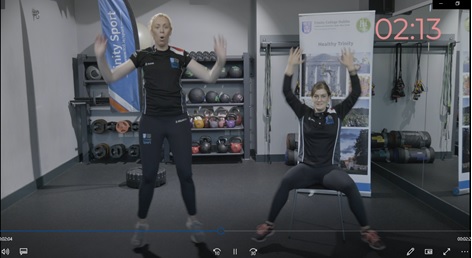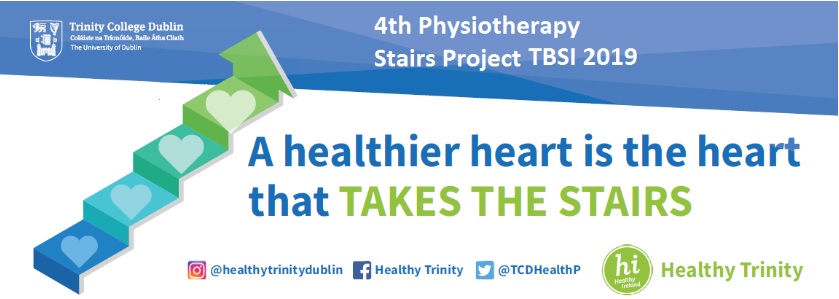Research
As part of Healthy Trinity's Living Lab approach, the following conference presenations and research has been undertaken by the physical activity group.
Conference Presentations
Health by Stealth: Embedding the Healthy Campus Agenda into the Curriculum
Dr Emer Barrett, Assistant Professor Discipline of Physiotherapy, School of Medicine, TCD.
Rationale
Healthy Trinity is a cross campus committee charged with enabling the vision of the Healthy Campus Framework(1). One of its guiding principles is to embed health into every aspect of campus operation.
Methods
We have successfully engaged both undergraduate and postgraduate students to design and deliver on several components of the Healthy Trinity agenda by integrating its mission and goals into project and research work. Taking the public health problem of sedentary behaviour, this presentation will outline how a social marketing campaign created by students from the Trinity Business School informed the design and development of a series of active break resources. The resources consist of short exercise videos and health promotional slides designed to break up prolonged sitting during lectures. Physiotherapy students completing their final year capstone project then carried out a feasibility study to establish the acceptability of integrating these active breaks into lectures.
Evaluation
This work involved the collaboration of multiple academic and operational partners across the University. Students were an integral part of the team gaining exposure to the real-life challenges of designing and implementing an intervention in a context that is highly relevant to them and their peers. Their work informed the delivery of a student led social media campaign, as well as the creation of several active break resources for the college community, a tangible outcome of the process. In addition, students advanced their research skills presenting their work at a national conference and successfully publishing their research in an international peer reviewed journal (2).
- Department of Health: Healthy Ireland: A Framework for Improved Health and Wellbeing, 2013-2025. (2013)
- Keating R, Ahern S, Bisgood L, Mernagh K, Nicholson GH and Barrett EM. Stand up, stand out. Feasibility of an active break targeting prolonged sitting in university students. Journal of American College Health 2020:1-7. doi: 10.1080/07448481.2020.1847119
Active Breaks
Objective: To assess the acceptability, appropriateness and feasibility of an active break designed to disrupt prolonged sitting in university students.
Participants: Students attending lectures in Trinity College Dublin, Ireland.
Methods: Participants took part in an active break which consisted of following a short exercise video lasting approximately 4 minutes. They then completed a validated questionnaire consisting of 12 statements with two open ended questions capturing likes/dislikes.
Results: Overall 106 (response rate 96%) predominately female (83%, n=87), health sciences students (91%, n=96) participated. Percentage agreement ranged from 93.4% (n=99) to 96.2% (n= 102) for acceptability, 84.9% (n=90) to 93.4% (n=99) for appropriateness and 80.2% (n= 85) to 96.2% (n=102) for feasibility. Space constraints and warm temperatures impacted negatively. 
Conclusion: An active break delivered during lectures is an acceptable and feasible intervention to disrupt sitting in students. Further investigation using a broader representation of the university population is needed prior to implementation.
Keating R, Ahern S, Bisgood L, Mernagh K, Nicholson GH and Barrett EM. Stand up, stand out. Feasibility of an active break targeting prolonged sitting in university students. Journal of American College Health 2020:1-7. doi: 10.1080/07448481.2020.1847119
Stair Prompts 
Background:Stair use is a simple and cost-effective method of increasing daily incidental physical activity. Initiatives encouraging stair use through the installation of point of decision prompts have been found to be widely effective. The aim of this study was to evaluate the effect of such an intervention on stair use within a health science building in Trinity College Dublin.
Methods:This was a time-series observational study during which stair and elevator use within the building were made pre-, mid- and post-intervention.
Results:A total of 2506 observations were recorded. Overall,no significant change in stair usage was found, however, a significant decrease in the number of users exiting the elevator on the second floor was recorded (p<0.05).
Discussion:Study results are discussed with reference to the feasibility and implementation of point of decisions prompts within a university environment.
Griffin S, White S, Flanagan K, Ryan S, Maguire F, Mullin M, Tanner M and Barrett EM. Doubling down on stair usage: The effect of point of decision prompts on stair usage in a university building. Irish Ergonomics Review 2019; 38-43. Available at: http://www.irishergonomics.org/wp-content/uploads/2019/06/Irish-Ergonomics-Review-2019.pdf
#MakeItFit Campaign
You can see the #MakeItFit, a six week physical activity promotion campaign on our campaigns page. This abstract about the campaign was accepted at the Irish Network of Healthcare Educators scientific meeting 2021.
Doubling Down on Stair Usage
Griffin S, White S, Flanagan K, Ryan S, Maguire F, Mullin M, Tanner M and Barrett EM. Doubling down on stair usage: The effect of point of decision prompts on stair usage in a university building. Platform presentation Irish Ergonomics Society Annual Conference, 2019, Dublin.

